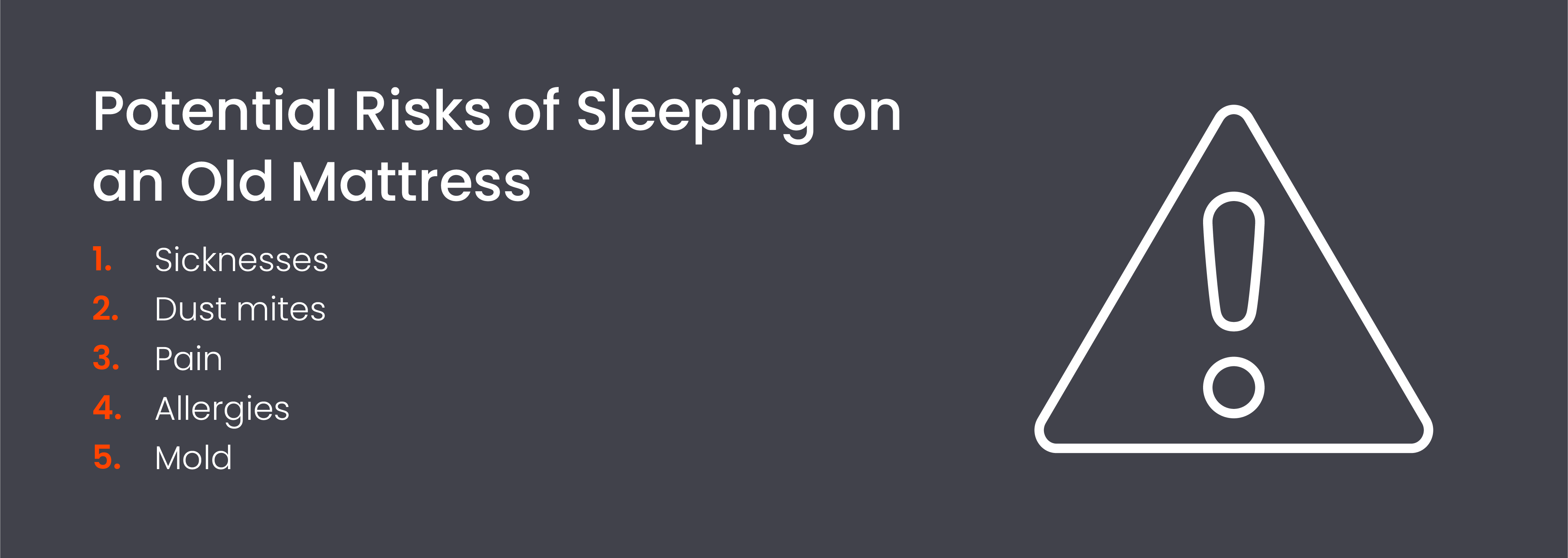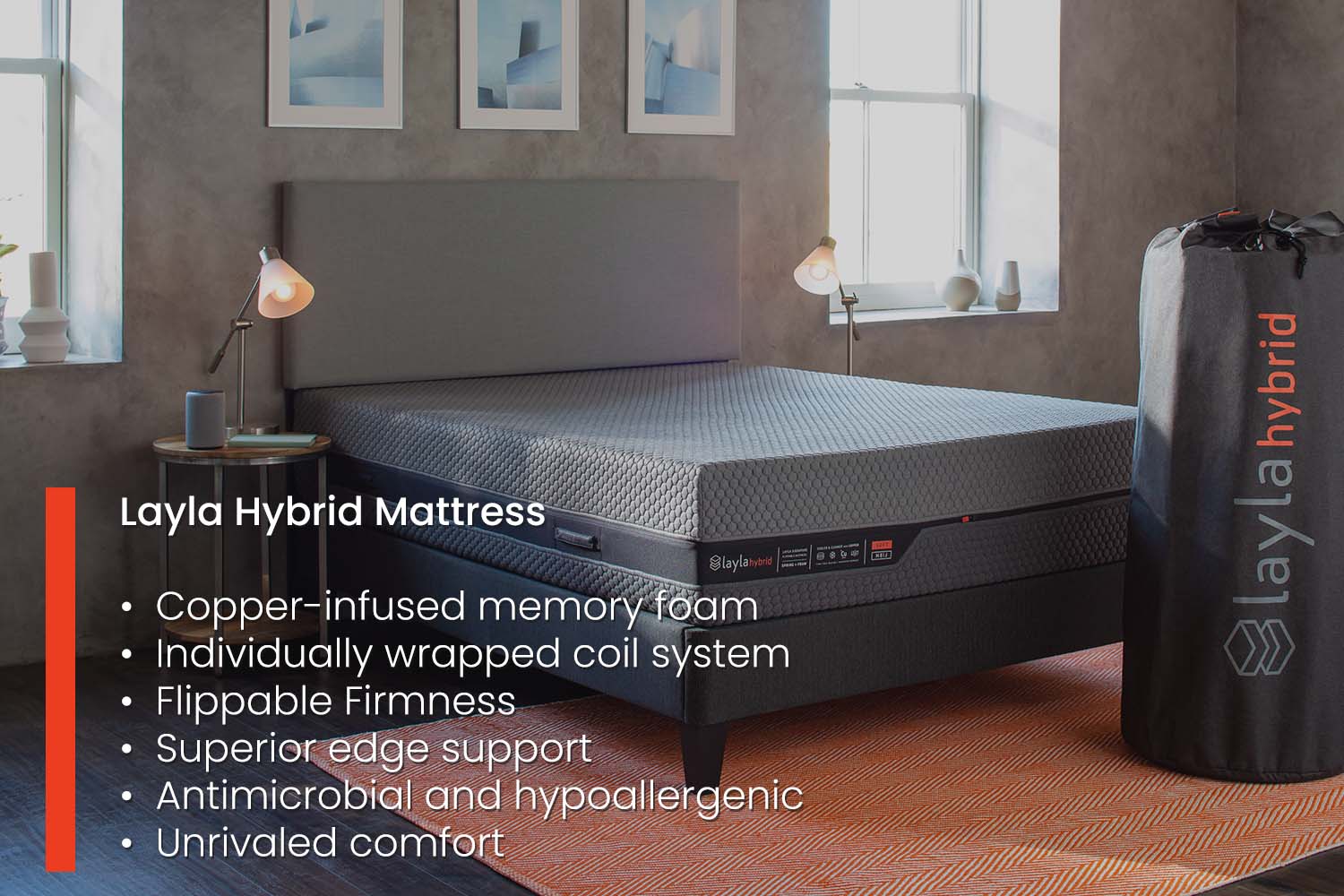- What Are Signs of an Old Mattress?
- How Long Do Mattresses Last?
- What Are the Risks of Sleeping on an Old Mattress?
- What Should You Look For in a New Mattress?
- Sleeping on a Layla Mattress
- Wrapping Up: Mattress Health Issues
What Are Signs of an Old Mattress?
High-quality mattresses are designed to last for several years, depending on the materials used to make them and how well you care for them. Unfortunately, you can’t always see the signs of an old mattress. Instead, old mattress health issues, such as pain, are more common. Additionally, if you’re sleeping on an old mattress, you might wake up feeling tired because of interruptions in your sleep throughout the night. Here are several common signs you should replace your mattress:

Age
Mattresses only last so long. Low-quality mattresses may only last a few years, while high-quality mattresses can last up to a decade. If you’re unsure how long your mattress will last, you can check the manufacturer’s guidelines for when it should be replaced.
Lumps
Lumpy mattresses can result in back, neck, or shoulder pain because they put your body out of alignment while you sleep. They can also cause frequent tossing and turning. In addition, a lumpy mattress isn’t comfortable, but you can try rotating it or flipping it (if possible) to reduce lumps in key areas of your body, such as your back, hips, and neck.
Sagging
All mattresses sag over time because they have to support your weight. Unfortunately, this can lead to uneven support over time, which can cause pain, especially in your back. If you see indentations from your body in your mattress, it’s time for a new one.
Poor sleep quality
An old mattress has lumps and sagging that can make it difficult to sleep at night, or you might find yourself waking up in the middle of the night. Over time, your mattress may also lose edge support, making it feel like you could roll off throughout the night. If you find yourself tossing and turning throughout the night to get comfortable, it can be an indication that it’s time to replace your old mattress.
Pain
Sleeping on an old mattress can cause back, neck, shoulder, and hip pain because it can no longer support your body. Remember, a good mattress keeps your body in proper alignment, giving you support where you need it based on your preferred sleeping position. Sleeping on a bad mattress means it can’t support your body, which can result in serious pain the next morning.
How Long Do Mattresses Last?
The average mattress lifespan is between seven to ten years, but different factors can affect this, such as mattress type, quality of materials used, and how well you take care of it. On average, innerspring mattresses usually last around eight years, with memory foam and hybrid mattresses lasting around ten years or more.

However, if you don’t take proper care of your mattress, you greatly reduce its lifespan. For example, if you allow your children to jump on your mattress or you frequently eat in bed and expose it to crumbs and moisture, it won’t last as long, regardless of the type. Other factors that affect your mattress’ lifespan include:
- Bodyweight: Heavier individuals can wear their mattresses much faster, increasing sagginess around the pressure points. For example, side sleepers push their hips into the mattress, resulting in sagginess over time because of uneven weight distribution.
- Amount of use: The less you use a mattress, the longer it will last. Of course, most of us use our mattresses every night, but you can extend its lifespan by only spending your sleep time on your mattress and avoiding using it for sitting to read or working in bed.
- Quality: Not all memory foam mattresses are created equal, and some use higher quality materials than others, which can greatly impact their lifespan.
What Are the Risks of Sleeping on an Old Mattress?
Mattress health issues are fairly common because many people sleep on a bad or old mattress without realizing it. Unfortunately, sleeping on a bad mattress can result in several potential health problems. Here are some potential old mattress health issues to be aware of:

Sicknesses
Sleeping on an old mattress can make you sick for several reasons. Sleep is crucial for your overall health. During sleep, your body can rest and repair itself after a long day, and it’s often during sleep that your body can focus on fighting illnesses like viruses. Unfortunately, a bad mattress can affect your sleep quality, making you more susceptible to illnesses because bad sleep results in poor immune system function.
In addition, sleeping on an old mattress can cause illness. For example, most people sweat in their sleep, and sweat can cause bacteria, mold, and yeast buildup that can enter your airways over time. Old mattresses harbor a host of organisms that can cause disease, especially if you haven’t cleaned them in a while. If your mattress is over ten years old, it’s much more likely to make you sick.
Dust mites
Dust mites are a common allergen, especially on mattresses. Dust mites are microscopic creatures that feed on dead skin cells, and since you shed skin in your sleep, you have no idea how many dust mites might be lurking under the covers with you. Dust mites excrete waste on your mattress, which can cause allergic reactions. Therefore, your old mattress could be a health hazard that causes severe allergy symptoms and can worsen asthma.

In addition to dust mites, an old mattress is more at risk of bedbugs, which feed on your blood while you sleep. They can hide in your mattress, sheets, and throughout your bedroom, resulting in red, itchy bumps on your body. Bed bugs are attracted to any area where you spend your time because they feed on you. Since you spend 8 hours every night in bed, they’re most common on mattresses and bedding. Additionally, the longer you keep an infested mattress, the harder it will be to eliminate the bed bugs from your home.
Pain
Pain is one of the most common symptoms of sleeping on a bad mattress. Old mattresses can become lumpy, bumpy, and saggy as a result of regular use and sleeping in the same spot, in the same position, for many years. Unfortunately, these lumps and sags can cause neck and back pain because they force your body out of alignment. When you sleep on your bed, your body relaxes, and if you have a saggy mattress, your body could end up not getting the support it needs.
Allergies
In addition to dust mites, mattresses can house other types of allergens, including dust and pet dander. Your mattress loves to collect dust, which is made worse when you sweat because that moisture allows dust and other allergens to stick to your bedding.
Additionally, if you’re a pet parent, your pet likely sleeps in bed with you, shedding dander from their skin or fur directly onto your mattress. Many people are allergic to pets, even if they don’t realize it. Since your bed can contain more dander than anywhere in the house if you sleep with your pet, it can eventually build up over time, resulting in worsened allergy symptoms.
Mold
Old mattresses can grow mold if they’re not in a well-ventilated bedroom. In addition, frequently spilling liquids like water on your mattress can allow for mold growth because it sinks deep into the mattress and makes it challenging to dry out completely, especially if you’re sleeping on top of it or have multiple layers of bedding.
Mold is a dangerous health hazard that can cause serious allergic reactions, including wheezing, headaches, and difficulty breathing. And, since you sleep directly on your mattress, it’s never a good idea to put your face anywhere near mold. With that said, if your bedroom smells mildewy or you can see visible mold growth, it’s time to get rid of your mattress.
What Should You Look For in a New Mattress?
Unfortunately, when your mattress reaches a certain age, you’ll need to get rid of it because it can potentially cause health issues that affect your quality of life. You can’t fix a bad or old mattress, especially if it causes pain or has become host to bacteria. Aim to replace your mattress at least every ten years, according to the manufacturer’s guidelines. When you’re ready to look for a new mattress, here are a few things to consider:

- Materials: Every mattress is different, but the materials you choose will ultimately impact the lifespan of your mattress and how durable it is. Mattresses can be made of foam, latex, and springs, allowing you to choose one that’s right for you based on your sleeping position and preferences. However, keep in mind that the materials have different lifespans. Higher-quality mattresses are usually worth it because they last much longer.
- Brand: Once you find a brand you trust, you can continue to get your mattresses from them for life. We recommend always choosing a brand you know and trust, or researching brands online to find customer reviews and ratings from trusted sources. For example, Layla’s Memory Foam Mattress was voted the Best Cooling Mattress in 2022 by Forbes.
- Certifications: You want a mattress you can trust, especially when shopping online. There are several types of certifications mattresses can have, including those that certify that the mattress doesn’t contain harmful chemicals. Layla uses CertiPUR-US Certified Memory Foam in its mattresses, certifying that our mattresses are free from potentially hazardous compounds, like formaldehyde and phthalates.
- Size: When it’s time to get a new mattress, consider upgrading to a larger size, especially if you share your bed with someone else. Getting a larger mattress can help you sleep better because it means getting more space. It’s also important to choose a mattress in the right size for your bedroom to ensure it fits comfortably with other bedroom furniture.
- Firmness: Many people have a firmness preference. Some prefer firm beds, while others like softer beds that feel like sleeping on a cloud. Your sleeping position may also dictate the firmness level you need. For example, individuals who sleep on their backs should have a firmer mattress, while those who sleep on their sides need a medium-firm mattress that allows their hips to sink in and keep their body in proper alignment. Don’t know which type of firmness you need? No problem. Layla offers Flippable Firmness to help you find the right side of the bed. Our soft side has a 4/10 firmness, and our firm size is a 7/10.
- Trial period: After receiving a new bed, there’s always a mattress adjustment period. If you’ve been sleeping on a saggy mattress for years, sleeping on a healthy, level mattress can be challenging because you’re not used to it. Finding a mattress with a trial period will help you determine whether it is truly right for you by allowing you to try it out before committing. Layla offers a 120-night risk-free sleep trial to ensure you love your mattress.
Need to learn how to get rid of a mattress? You have several options: donating, selling, recycling, and tossing it in the dumpster. Getting rid of an old mattress will likely mean throwing it away because if it’s not safe for you, it’s not safe for anyone. You can call your local disposal company to schedule a curbside pickup or drop it off at any of their locations.
Sleeping on a Layla Mattress
Layla’s Memory Foam and Hybrid Mattresses can help you get better sleep. Both mattresses offer Flippable Firmness to help you find the right side. In addition, our mattresses are infused with copper, offering variable support that reacts to pressure with a firming response to stay soft where you need it while providing ample support.

In addition, copper can help you sleep cooler by drawing heat away from the body rather than absorbing it. And copper is naturally antimicrobial and resistant to common allergens like dust and bacteria to help you breathe easier while you sleep.
Wrapping Up: Mattress Health Issues
Common mattress health issues, such as allergies, pain, and sickness, are completely avoidable by swapping your old mattress every seven to ten years. The right mattress can reduce daytime sleepiness and improve overall sleep quality to ensure you get the sleep you need to feel your best the next day. Sleep better with Layla. Browse our collection of mattresses, bedding, pillows, and accessories.



